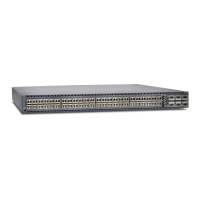To install a transceiver in an ACX5000 router:
CAUTION: To avoidelectrostaticdischarge(ESD)damageto the transceiver,
do not touch the connector pins at the end of the transceiver.
1. Remove the transceiver from its bag.
2. Check to see whether the transceiver is covered by a rubber safety cap. If it is not,
cover the transceiver with a rubber safety cap.
WARNING: Do not leave a fiber-optic transceiver uncovered except when
inserting or removing a cable. The rubber safety cap keeps the port clean
and prevents accidental exposure to laser light.
3. If the port in which you want to install the transceiver is covered with a dust cover,
remove the dust cover and save it in case you need to cover the port later.
4. Using both hands, carefully place the transceiver in the empty port. The connectors
must face the device chassis.
CAUTION: Before you slide the transceiver into the port, ensure that the
transceiver is aligned correctly. Misalignment might cause the pins to
bend,making the transceiver unusable. See Figure 52 on page 144 through
Figure 54 on page 144 for the correct orientation for your router.
5. Slide the transceiver in gently until it is fully seated. See Figure 52 on page 144 for an
example of inserting an SFP transceiver. Figure 53 on page 144, and Figure 54 on page 144
are examples of inserting QSFP+ transceivers into different ACX5000 router product
SKU devices.
6. Remove the rubber safety cap when you are ready to connect the cable to the
transceiver.
WARNING: Do not look directly into a fiber-optic transceiver or into the
ends of fiber-optic cables. Fiber-optic transceivers and fiber-optic cables
connected to transceivers emit laser light that can damage your eyes.
143Copyright © 2015, Juniper Networks, Inc.
Chapter 17: Replacing Transceiver

